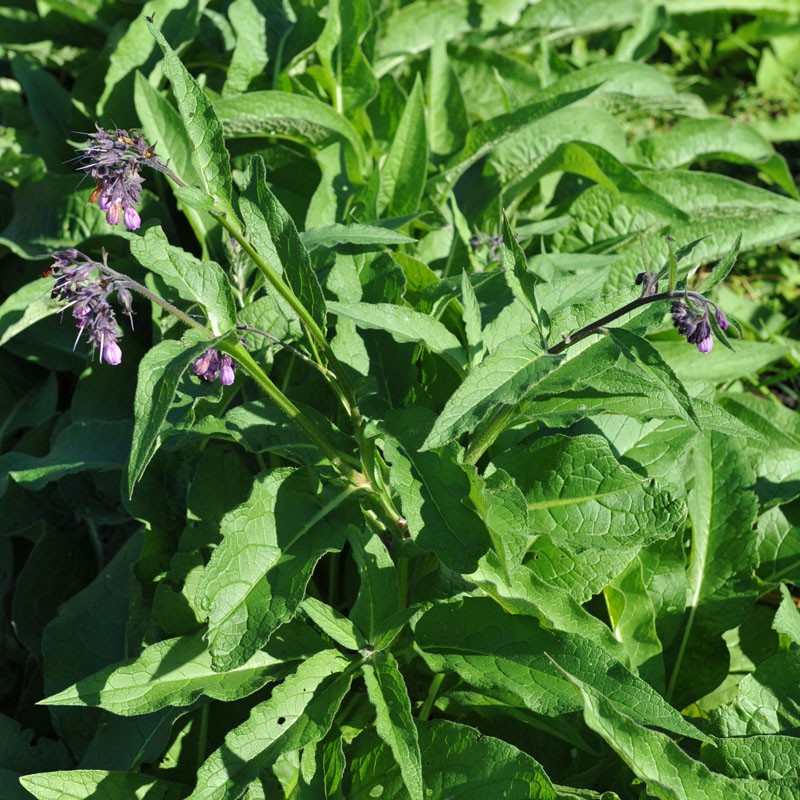Russian Comfrey Plant
Symphytum x uplandicum
The roots of Comfrey can go down 10 feet (3 metres) into the soil and help to raise moisture and valuable minerals in the soil.
- Makes great plant food.
- Bees love the flowers.
Supplied as a pot grown plant grown in a 7cm pot.
This Product is Available Now.1 or more £2.95GBP each. Group & quantity discounts
Description
Much prized by organic growers, Russian Comfrey produces huge leaves that make an excellent potash fertilizer for tomatoes and potatoes. Leaves are cut and put into a tub with water to make a very nutritious feed for all garden plants.
Not edible.
Essentially grown for compost-making since it fixes many nutrients and trace elements through its growth.
- Perennial (does die down in winter).
- Reaches 3-5 feet (1-1.5 metres) tall.
- Invasive (think about where you are going to plant it first!)
- Likes a moist soil, and will grow in clay soils.
- Will take sun or shade.
- Flowers May-July with pinky/lilac/blue flowers.
- Wear gloves when handling as can cause skin irritation.
- Bees love the flowers.
- Culinary Uses
- Young leaves can be cooked like spinach or asparagus - do NOT eat old leaves.
- Medicinal Uses
- Helps stimulate new cell growth, repair tissue and cartilage.
- Has anti-inflammatory and anti-fungal properties.
- Good for helping bruises, cuts, sores, sprains and over-strained muscles.
- Can help varicose veins.
- Gentle solution for diarrhoea and IBS.
- Can help stomach ulcers.
- Will ease rheumatism, bronchial diseases and bleeding haemorrhoids.
- Can be used to help fractured ribs.
- Other Uses
- Makes a good plant/tomato feed - has a high potash content.
- Can be used to soften skin.
Disclaimer
As with all alternative medicines and plants with purported medicinal benefits it is important to inform your health care providers that you are using them; this helps to ensure safe and coordinated care. We can accept no liability for any side effect or contingency from any allergy or any other cause or harm that may arise. If in doubt please do consult a medical practitioner before using. Do not take in large quantities or over a long period of time as may cause liver damage or have carcinogenic effects. Not recommended for use if pregnant or breast feeding.
To Make Fertiliser
Soak the leaves in water for approximately 4 weeks (this can be very smelly. We suggest using a container with close-fitting lid). This produces a potash-high feed ideal for tomatoes and potatoes.
Alternatively you can pick the leaves and leave them for at least 48 hours and then use them as a mulch.
Some gardeners also lay comfrey leaves in trenches in which they then plant potatoes.
Grows huge leaves. Primarily used and prized by organic growers.
Pricing
This Product is Available Now.This product is subject to group discount if you are buying multiple products from the same pricing group. Other products in this group are...
Angelica Plant
Anise Hyssop Plant
Basil Plant - Holy Basil
Basil Plant - Thai Basil
Basil Plant Sweet Genovese
Bergamot Plant - Wild Bergamot
Burn Jelly Plant
Caraway Plant
Catgrass Plant
Catnip Plant
Catnip Plant - Lemon Catnip
Chamomile Plant
Chamomile Plant - Dyer's Chamomile
Chive Plant
Chive Plant - Garlic Chives
Coriander Plant - Coriander 'Leisure'
Curry Plant
Epazote Plant
Fennel Plant
Fennel Plant - Bronze Fennel
Feverfew Plant
Hyssop Plant - Blue
Hyssop Plant - Pink
Hyssop Plant - White
Lady's Mantle Plant
Lavender Plant - Lavender 'Ellagance Snow'
Lavender Plant - Lavender 'Pink Perfume'
Lavender Plant - Lavender 'Vera'
Lavender Plant - Lavender Castilliano Violet
Lemon Balm Plant
Lemon Balm Plant - Lemon Balm 'All Gold'
Lemon Grass 'East Indian' Plant
Lemon Verbena Plant
Lovage Plant
Mace Plant
Marjoram Plant
Marsh Mallow Plant
Mint Plant - Apple Mint
Mint Plant - Banana Mint
Mint Plant - Basil Mint
Mint Plant - Black Peppermint
Mint Plant - Blackcurrant Mint
Mint Plant - Chocolate Mint
Mint Plant - Corsican Mint
Mint Plant - Curly Mint
Mint Plant - Eau De Cologne Mint
Mint Plant - Garden Mint
Mint Plant - Ginger Mint
Mint Plant - Grapefruit Mint
Mint Plant - Lemon Mint
Mint Plant - Lime Mint
Mint Plant - Mojito Mint
Mint Plant - Moroccan Mint
Mint Plant - Peppermint
Mint Plant - Pineapple Mint
Mint Plant - Red Mint
Mint Plant - Russian Mint
Mint Plant - Silver Mint
Mint Plant - Spearmint Plant
Mint Plant - Strawberry Mint
Myrtle Plant
Oregano Plant
Oregano Plant - Country Cream
Oregano Plant - Greek Oregano
Parsley Plant - Parsley 'Champion Moss Curled'
Parsley Plant - Parsley 'Italian Giant'
Rosemary Plant - Common Rosemary
Rosemary Plant - Green Ginger Rosemary
Rosemary Plant - Rosemary 'Primley Blue'
Rosemary Plant - Rosemary 'Seven Seas'
Rosemary Plant - Rosemary 'Sudbury Blue'
Rue Plant
Sage Plant - Blackcurrant Sage
Sage Plant - Clary Sage
Sage Plant - Common Sage
Sage Plant - Golden Sage
Sage Plant - Purple Sage
Savory Plant - Summer Savory
Savory Plant - Winter Savory
Self-heal Plant
Siberian Onion Plant
Sorrel Plant - Broad-leaf Sorrel
Stevia Plant
Sweet Cicely Plant
Sweet Woodruff Plant
Tansy Plant
Tarragon Plant - French Tarragon
Tarragon Plant - Mexican Tarragon
Tarragon Plant - Russian Tarragon
Thyme Plant - Common Thyme
Thyme Plant - Lemon Thyme
Thyme Plant - Orange Thyme
Thyme Plant - Thyme Silver Queen
Valerian Plant - Common Valerian
Woad Plant
Wormwood Plant
Yarrow Plant 'Wild Yarrow'
How To...
How To Sow & Grow Herbs
Detailed advice on sowing and growing herbs outside and under protection. Includes information on watering and pest control.
Related Products
If buying Russian Comfrey Plant you may find the following items of interest... Bio Sterilant Mustard Seed
Bio Sterilant Mustard Seed Wild White Clover Seed
Wild White Clover Seed


